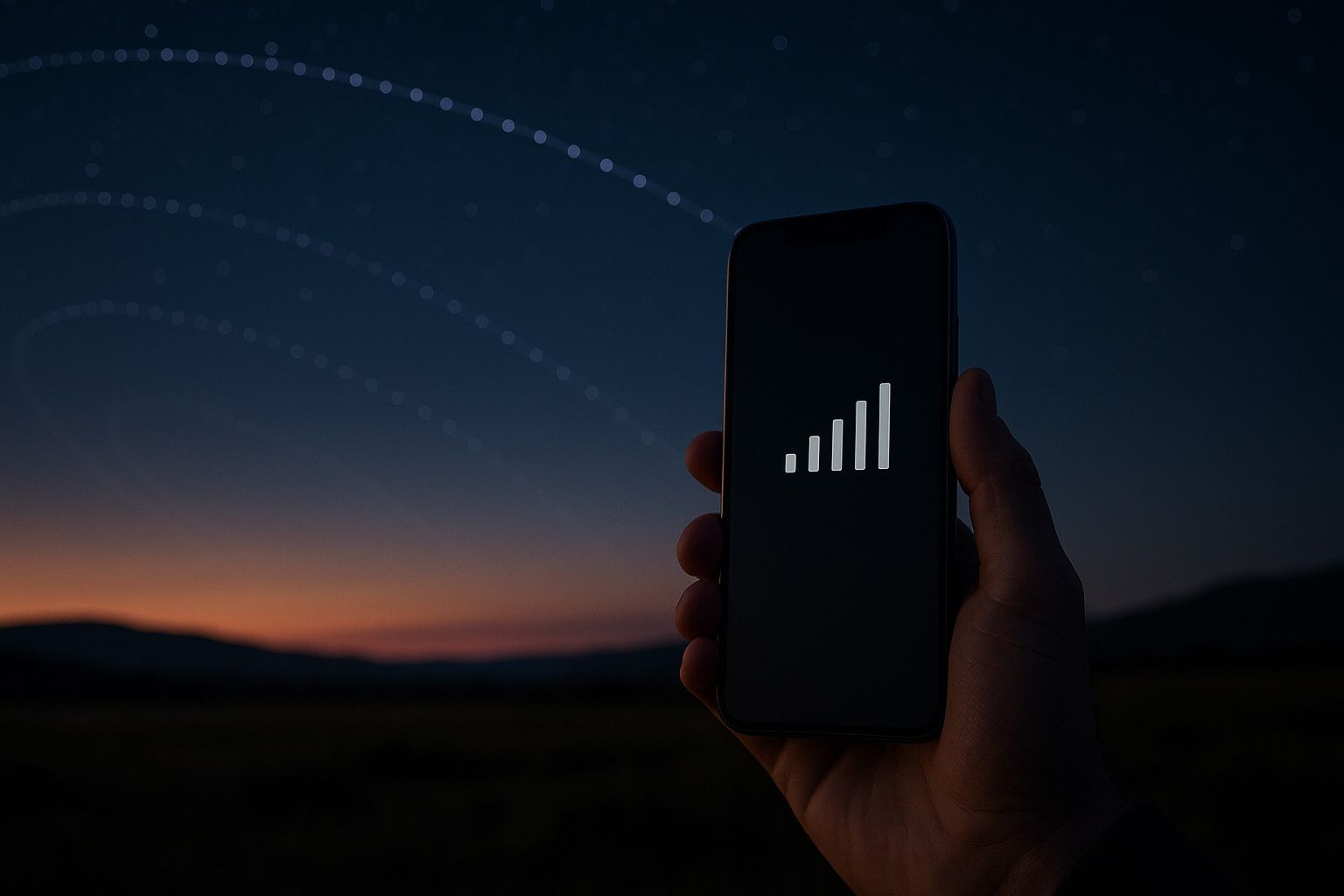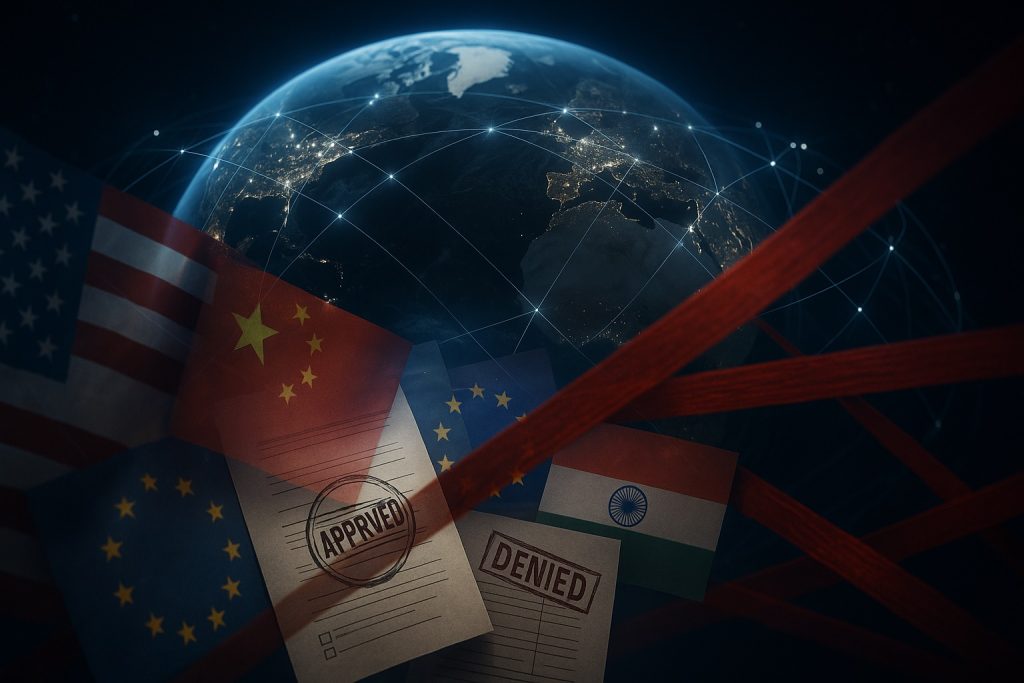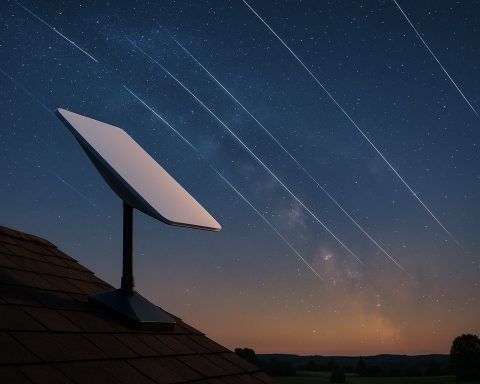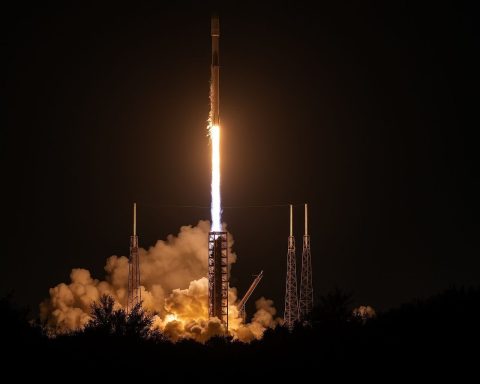- August 2022: SpaceX and T-Mobile announced a partnership to provide direct-to-cell connectivity via Starlink satellites, with texting expected in 2023–24 and voice/data thereafter.
- January 2024: SpaceX achieved the first SMS directly via satellite, enabling a two-way text conversation between ordinary smartphones relayed entirely through space after the first batch of D2C-equipped satellites launched.
- Gen2 Starlink satellites carry the Direct-to-Cell payload, and the smaller V2 Mini satellites launched on Falcon 9 in 2023–24 were equipped to support these tests.
- By late 2024, more than 400 Starlink satellites had Direct-to-Cell capability, enabling voice calls, video calls, and IoT tests such as Cat-1 sensors.
- November 2024: The FCC granted conditional approval for commercial Direct-to-Phone service, requiring coordination with NASA if operating below about 400 km altitude.
- End of 2024: Starlink Direct-to-Cell entered a beta with text service live for US customers via T-Mobile and New Zealand via One NZ.
- Early 2025: Public beta expanded; T-Mobile opened the program to non-customers for testing, and by February 2025 SpaceX declared the service commercially available in the US and NZ.
- Technical setup uses licensed 4G LTE spectrum in the 1.6–2.7 GHz range via an onboard 4G LTE base station (eNodeB) on each Direct-to-Cell satellite, allowing standard phones to roam onto the satellite link.
- Current limitations include SMS-only and very basic data, no regular web or voice calls yet, latency that can reach tens of seconds to minutes, outdoor sky visibility requirements, and optional test-based free access in the US beta through mid-2025.
- Future plans call for adding data and IoT services in 2025, then voice calls and higher bandwidth, with Gen2/Starship launches expanding capacity and more carrier partnerships worldwide.
Imagine sending a text from the middle of the ocean or deep in the mountains with no cell tower in sight. That’s the promise of Starlink’s new Direct-to-Cell technology – a “cell tower in space” that lets ordinary phones connect via satellite when terrestrial coverage is absent. In recent trials, SpaceX’s Starlink satellites have successfully relayed SMS texts and even voice/video calls directly to standard smartphones, showcasing a potential game-changer for mobile connectivity. This report dives into what Starlink Direct-to-Cell is, its key milestones (including SMS and voice trial phases), the partners and timelines involved, and what it all means for the telecom industry and consumers around the world.
What Is Starlink Direct-to-Cell?
Starlink Direct-to-Cell is a satellite-based cellular service designed to eliminate mobile dead zones by connecting unmodified 4G LTE phones directly to orbiting satellites [1] [2]. In essence, each equipped Starlink satellite functions like a floating cell phone tower in space, with an onboard 4G LTE base station (technically an eNodeB) that communicates with standard phones on the ground [3]. Unlike traditional satellite phones, users do not need any special hardware or apps – any normal smartphone can connect, as long as it supports the frequency band used and has a clear view of the sky [4]. The satellites then route calls or messages through SpaceX’s Starlink network of satellites and down to the partner carrier’s network on Earth, integrating as if they were just another roaming cell site [5].
Illustration of how Starlink Direct-to-Cell connects ordinary cell phones through satellites. The satellites act as space-based cell towers, linking user phones to the carrier’s network via Starlink’s orbital constellation. [6] [7]
Technical aspects: This ambitious setup requires surmounting significant technical challenges. Satellites orbiting a few hundred kilometers up move rapidly (~27,000 km/h) relative to a phone, so the system must handle rapid hand-offs, Doppler shift in signal frequency, and higher latency than ground networks [8]. Additionally, a phone’s tiny antenna and limited power present a “link budget” challenge – ensuring the signal is strong enough both ways over the vast distance [9]. SpaceX’s engineers developed new phased-array antennas, custom silicon chips, and smart algorithms aboard the satellites to optimize the signal beams and overcome these obstacles [10]. In fact, Starlink’s second-generation satellites (Gen2) carry this advanced direct-to-cell payload; even the smaller V2 “Mini” satellites launched on Falcon 9 rockets in 2023-24 were equipped to support these tests [11]. Essentially, each satellite uses licensed 4G LTE spectrum (in the ~1.6–2.7 GHz range) provided by mobile carrier partners, enabling phones to connect to the satellite just as they would to a normal cell tower on that frequency [12]. The result is a seamless roaming experience: if you wander out of cell range but have sky above, your phone can switch to the satellite signal and stay connected.
Key Milestones and Breakthroughs
Starlink’s direct-to-cell journey has moved fast – reaching initial service in barely over a year since the concept was unveiled. Here are some key milestones and technical breakthroughs along the way:
- August 2022 – “Coverage Above & Beyond” Announcement: SpaceX and T-Mobile (USA) first announced their partnership to use Starlink satellites for direct phone connectivity, vowing to end dead zones by leveraging T-Mobile’s spectrum [13]. This high-profile event laid out an ambitious timeline: texting by 2023/24, with voice and data to follow.
- Early 2023 – Regulatory Filings and Preparations: SpaceX filed with the U.S. FCC in late 2022 for approval to use existing mobile bands from space, anticipating tests in 2023 [14]. Other countries’ regulators and global standards bodies (3GPP) also began crafting rules for “supplemental coverage from space,” since using satellites as cell sites is a novel scenario. SpaceX started launching Gen2 Starlink satellites in 2023, many carrying the Direct-to-Cell hardware needed for trials [15].
- January 2024 – First SMS Directly via Satellite: In a breakthrough test, SpaceX confirmed it sent and received text messages via unmodified cell phones using Starlink satellites in orbit [16]. Within nine days of launching the first batch of D2C-equipped satellites, the team achieved a two-way SMS conversation between ordinary smartphones on Earth, relayed entirely through space [17]. “This validates that our link budget closes, and the system works,” the Starlink team announced, sharing a photo of two standard phones successfully texting each other via the satellite link [18] [19]. This proved the core technology and radio link are viable.
- Mid–Late 2024 – Voice & Data Tests, Emergency Uses: As more satellites deployed (over 400 by late 2024 had Direct-to-Cell capability [20] [21]), SpaceX expanded testing to higher-bandwidth services. They achieved voice calls and even video calls using apps like X (Twitter) and WhatsApp over the satellite connection – demonstrating that real-time communication is possible with the system [22]. They also successfully connected IoT devices (e.g. low-power Cat-1 sensors) in tests, hinting at future M2M applications [23]. In an unexpected trial by fire, Starlink Direct-to-Cell was leveraged during disasters: when Hurricanes Helene and Milton struck, and during major wildfires in California, SpaceX got special FCC waivers to activate the satellite-cell service for emergency use [24]. This allowed affected T-Mobile customers with no ground coverage to send text messages and receive Wireless Emergency Alerts via satellite, providing a lifeline in areas where all normal networks were down [25].
- November 2024 – FCC Approval and Service Launch: After extensive testing, SpaceX obtained conditional approval from the U.S. FCC to begin commercial direct-to-phone services [26] [27]. (One condition: Starlink must coordinate with NASA before using certain lower orbits, so initial satellites operate above 400 km altitude [28].) With this green light, Starlink Direct-to-Cell officially moved from experiment to service. By the end of 2024, SpaceX and T-Mobile opened a beta program for users, and satellite SMS service became live for the first customers in the United States and New Zealand [29] [30].
- Early 2025 – Public Beta and Expansion: In early 2025, T-Mobile began rolling out an open beta of the Starlink-powered texting service to its subscribers (and even non-T-Mobile users for testing) [31] [32]. Millions of messages have already been sent through the system during the beta and disaster trials in 2024 [33] [34]. By February 2025, SpaceX declared the satellite messaging service “commercially available” in the U.S. (via T-Mobile) and NZ (via One NZ) – effectively the world’s first direct-to-cell satellite texting service [35] [36]. Plans for later in 2025 include gradually enabling voice calling and modest data capabilities once enough satellites and ground integrations are in place [37] [38].
SMS and Voice Trials: How Do the Tests Work?
Text Messaging Trials: The initial focus has been on SMS texting, given its relatively low bandwidth and high usefulness for safety. In the beta phase, users with compatible phones (any recent phone supporting the partner carrier’s LTE band, such as T-Mobile’s Band 1900 MHz PCS) can send normal text messages when they have no cellular signal, by connecting through a Starlink satellite overhead. In tests, the phone simply shows it’s roaming (to a network identifier that T-Mobile/Starlink uses), and messages take only slightly longer to send. Starlink’s trial in January 2024 proved that two phones on opposite sides of the country could exchange texts via space [39] [40]. During the ongoing open beta in 2025, T-Mobile has even invited customers of rival carriers (AT&T, Verizon) to try the satellite texting for free, underscoring the cooperative nature of this test and gathering feedback from diverse devices [41] [42]. So far, the outcomes have been very promising – SpaceX reports that in 2024 alone, “millions of messages were sent through Starlink Direct to Cell during beta testing and emergency scenarios” [43] [44], validating that the system can handle real-world use at scale for basic messaging.
Voice Call Trials: While not yet open to consumers, SpaceX has conducted successful voice trials internally using the satellite link. According to Starlink, engineers managed to complete voice calls – and even video calls – between standard smartphones using the satellites as relays [45]. These calls (including one reportedly using a popular social app for video chat) demonstrate that the network can support interactive audio/video when bandwidth allows. However, voice services for the public will roll out more cautiously. T-Mobile’s demo at the 2025 Super Bowl teased satellite-based calling and picture messaging, but the company clarified that these features are “coming later” once the text-only beta is complete [46]. The tentative plan is to introduce voice calling after SMS is fully proven – likely in late 2025 – followed by incremental data capabilities. The trials so far indicate voice is feasible, but quality and reliability need to be ensured given the higher latency (a Starlink satellite connection might add a few hundred milliseconds round-trip). SpaceX’s partner AST SpaceMobile (a separate company) actually beat Starlink to the first satellite phone call in April 2023 using a prototype satellite with a huge antenna [47] [48], proving that direct voice service is technically possible. Starlink’s approach, with many smaller satellites instead of a few giant ones, will aim to achieve similar voice coverage with a different architecture – it’s now a matter of deploying enough satellites and fine-tuning the network.
Trial Partners and Timeline: The development of Direct-to-Cell has been a global effort in partnership with mobile network operators. T-Mobile in the U.S. was the flagship partner (providing spectrum and a large user base for beta testing), but carriers around the world quickly signed on. By 2025, SpaceX has agreements with over a dozen operators, including One NZ in New Zealand, Rogers in Canada, Optus and Telstra in Australia, KDDI in Japan, Salt in Switzerland, and even Entel in parts of South America [49] [50]. These partners are at various stages of testing and regulatory approval. One NZ, for instance, joined T-Mobile in launching the first commercial beta for texting in late 2024. Others (like Optus in Australia and Rogers in Canada) are slated to begin trials in 2025 as the satellite constellation and ground integrations expand [51] [52]. The broad timeline is: 2024 for text trials, 2025 for voice and low-rate data trials, and beyond 2025 for full global rollout of multi-service coverage [53] [54]. Each phase requires not only technical readiness but also local regulatory clearance, which is why some countries will come online later. So far, trial outcomes have shown that even in remote jungles, deserts, or ocean regions, a basic text can go through – a landmark change in what a “coverage map” means.
Impact on the Telecom Industry and Remote Connectivity
Starlink’s Direct-to-Cell service stands to reshape the telecom landscape, especially for remote and underserved areas. For decades, carriers have wrestled with the cost of covering rural or rugged regions – building and maintaining terrestrial towers in low-traffic zones often isn’t economical. The result: “dead zones” where no bars are available and users are cut off. Satellite-cell integration flips this model by providing blanket coverage from above. Even in the most isolated village, on a boat offshore, or on a hiking trail in the wilderness, basic connectivity becomes possible for anyone with a standard phone. This could dramatically improve safety (e.g. the ability to call for help from anywhere or receive emergency alerts) and enable connectivity for people who live in areas that may never get ground towers [55] [56]. In developing regions, it could leapfrog the need for extensive infrastructure, helping close the digital divide.
For the telecom industry, the technology is both an opportunity and a disruptor. Many mobile network operators see partnering with satellite providers like Starlink as a way to augment their coverage without huge capital outlays – essentially offloading the toughest coverage zones to satellites. The global partnership model Starlink touts means a subscriber of one network could have coverage via satellite in any other partner’s territory, which is a win-win for carriers and consumers [57] [58]. For example, a T-Mobile user might get connectivity in remote Canadian wilderness through Rogers’ partnership, and vice versa, all through the same Starlink satellite network. Additionally, industries like shipping, aviation, and agriculture are eyeing this tech for IoT connectivity – think sensors on ocean buoys or smart farming equipment sending data from far afield, using the satellites as relays where cell service never existed.
However, traditional satellite communications providers and some carriers have expressed concerns. Companies like Iridium and Globalstar (which enable specialized satellite phones and devices) could face new competition if everyday phones gain satellite abilities. And some telecom rivals are pursuing their own approaches: for instance, AST SpaceMobile (backed by AT&T and others) is launching satellites with gigantic antennas to offer direct phone links, and has already demonstrated 4G voice calls and even a 5G connection from space in tests [59] [60]. Tech giants are also entering the fray – Apple’s recent iPhones can send emergency texts via satellite (using Globalstar’s network), albeit for emergency use only. All this points to a convergence of satellite and terrestrial telecom. In the long run, consumers may not even know (or care) whether their phone is connected to a tower or a satellite – it will simply be “connected everywhere.” Starlink’s aggressive push, given its growing constellation, puts pressure on competitors and could accelerate a new era of hybrid connectivity.
Regulatory Challenges and Approvals
Launching a space-based cellular network isn’t as simple as flipping a switch – it’s required navigating a maze of regulatory approvals and spectrum coordination. In the U.S., SpaceX had to secure permission from the Federal Communications Commission (FCC) to use mobile spectrum from space. This was unprecedented, as those frequencies (like 1910–1995 MHz PCS band) are traditionally licensed for ground towers. After a lengthy review and even some legal sparring, the FCC granted SpaceX a temporary experimental license in late 2023 to test direct-to-cell communications with about 60 satellites over the U.S. [61] [62]. This 6-month trial authorization let SpaceX prove the concept while the FCC worked on rules for full deployment. Not everyone was on board initially – AT&T filed objections trying to block the Starlink-T-Mobile plan, arguing that satellite signals in these bands could interfere with neighboring cellular networks on the ground [63] [64]. In particular, AT&T worried about interference since Starlink’s smaller satellites produce a wider footprint beam that could spill into frequencies AT&T uses [65]. SpaceX countered that it can avoid harmful interference, and the FCC decided to let the tests proceed to gather data [66] [67].
By November 2024, U.S. regulators gave conditional but official approval for SpaceX to begin offering direct-to-phone service commercially [68] [69]. The “conditional” part included working with NASA to ensure Starlink’s Gen2 satellites don’t pose collision risks at certain altitudes (mandating coordination if operating below ~400 km) [70]. It also likely requires ongoing spectrum sharing safeguards to protect other users. Similar regulatory hurdles exist abroad: Starlink and its partners must get permission country by country. Encouragingly, regulators in places like New Zealand and Canada have also moved forward, allowing tests with One NZ, Rogers, etc., under their oversight. International bodies such as the ITU are monitoring this new use of spectrum from space to update global regulations as needed.
One interesting aspect is the FCC’s development of a framework for “Supplemental Coverage from Space.” In mid-2023, the FCC started establishing rules so satellite operators and terrestrial carriers can jointly provide coverage, reflecting the very model Starlink is pioneering [71]. This framework sets entry requirements and interference protections, effectively opening a path for services like Starlink D2C and others to legally operate as part of mobile networks. By early 2025, SpaceX’s regulatory groundwork in the U.S. was solid enough that the service could launch in beta to consumers. Going forward, continued cooperation with regulators will be vital – from allocating spectrum fairly (e.g. ensuring one satellite network doesn’t hog frequencies) to coordinating debris mitigation (so the thousands of satellites needed don’t exacerbate space junk concerns). Thus far, Starlink’s strategy of partnering with licensed mobile operators in each country has smoothed the process, since it leverages spectrum those carriers already control [72] [73]. In summary, while there were significant regulatory hoops to jump through, Starlink’s direct-to-cell has obtained the key approvals to operate in its first markets, with more likely on the way as other nations see the benefits.
User Expectations and Limitations
For everyday users, the idea of sending a message from anywhere on Earth is exciting – but it’s important to set realistic expectations in these early days. Currently, Starlink’s Direct-to-Cell service is limited to SMS text messaging and very basic data. That means you can send standard text (and in some cases small images or emojis), but you cannot yet browse the web, stream video, or make ordinary voice calls via satellite on your phone. In fact, T-Mobile’s public beta explicitly supports “texting in dead zones” and 911 emergency text, with no voice service and no general internet until future updates [74] [75]. Even when voice is introduced, it might at first be primarily for emergency use or occasional calls, rather than long chats, due to limited capacity.
The performance of the service will also be very different from normal 4G/5G coverage. Users should expect that sending a message via satellite could take tens of seconds or even a couple minutes in some cases, depending on satellite positions. There may be times when you have to wait for a satellite pass to get a message through (though with hundreds of satellites in orbit, the system is designed so that one should be overhead fairly often). Early on, the service might only work outdoors with a clear sky view – being inside a building or under heavy tree cover will likely prevent a direct satellite link. Essentially, the first phase is akin to a safety net: it’s not meant to replace terrestrial networks in quality, but to be available when nothing else is.
There will also be device and carrier limitations. Only newer phones that support the specific LTE band used by your carrier’s satellite partnership will work. Fortunately, most modern smartphones do support the common bands (for example, T-Mobile is using part of Band PCS, which most phones have [76]). No firmware update is needed; the phone sees the satellite as a roaming cell. Carriers may eventually require you to enable satellite messaging in your plan. In the U.S. beta, T-Mobile has actually made it free for anyone to test (even non-customers) until mid-2025 [77]. But once fully launched, they indicated it will be included only on certain premium plans, or as a ~$10–$20 per month add-on for others [78] [79]. This suggests that while lifesaving emergency texts might be enabled for all, using the satellite link for routine messaging could come at a small extra cost, depending on your provider.
Another limitation is bandwidth. The satellite essentially creates a cell that might cover a huge area (hundreds of miles across). All users in that footprint share the satellite’s limited LTE capacity, which is far less than a typical cell tower. Thus, the network will prioritize low-bandwidth uses – texts, WhatsApp messages, small emails. Don’t expect to FaceTime over satellite just yet. T-Mobile’s Mike Katz noted that apps which “don’t require super-fast data” will be supported, and they are working with app developers to optimize for the very constrained satellite bandwidth [80] [81]. For instance, a mapping app might download only critical bits of map data when on satellite, or a messaging app might compress images heavily. Users might see some features disabled automatically when the phone knows it’s on satellite mode (to conserve the limited throughput).
Finally, it’s worth noting that coverage won’t be 100% continuous at first. As Starlink launches more satellites, coverage gaps will shrink. But in the initial phase, there could be times (especially at extreme latitudes or certain regions) where no satellite is immediately available for a few minutes. This will improve as the constellation grows. SpaceX’s ultimate goal is “ubiquitous” coverage [82] [83], and given they plan to scale to thousands of second-gen satellites, your phone should rarely be out of reach of at least one in the future. Until then, users should see this as a backup service – incredibly useful for an emergency or quick check-in off-grid, but not a replacement for terrestrial networks for high-bandwidth needs.
Forward-Looking Insights: Data Service and What’s Next
The successful SMS and voice trials are just the beginning. Starlink’s Direct-to-Cell roadmap envisions adding more capabilities step by step. According to SpaceX, 2025 will bring the start of Data and IoT services, expanding beyond texting [84]. This means by later 2025, users might be able to send picture messages, use lightweight messaging apps, or even get low-speed internet access on their phone via satellite. In fact, T-Mobile hinted that by the end of the current beta (mid-2025) they aim to support some messaging apps and limited multimedia (like low-res photos) over the satellite link [85] [86]. IoT support will likely follow the same timeframe – for example, smart devices in agriculture, transportation, or environmental monitoring could start linking up through Starlink satellites using standard LTE modems [87] [88]. This could unlock connectivity for millions of sensors in remote areas (think of pipelines, weather stations, or cattle trackers far from cell towers) [89] [90].
Looking further ahead, full voice calling and richer data services are on the horizon. SpaceX’s official materials suggest that voice service is “coming soon” after texting, and data services ramping up in 2025 [91]. It’s possible that by 2026, we’ll see truly global calling where you can dial or receive a normal phone call in the wilderness with no interruption. Data speeds will still be modest – perhaps a few megabits per second at best per user in early years – but enough for essential connectivity. Over time, as technology improves, even 5G from space could become a reality. The direct-to-cell satellites might evolve to support 5G NR signals or higher bandwidth as spectrum allows. (Notably, AST SpaceMobile already demoed a basic 5G connection from a satellite in 2023 on a test-band; Starlink could follow suit down the road.)
Starlink’s ongoing launches and the planned debut of the larger Starlink Gen2 satellites (on Starship rockets) will massively increase network capacity. The Gen2 satellites are expected to have improved antennas and more power, which could expand the service beyond the initial limitations. As of early 2025, SpaceX has been using Falcon 9 to launch “V2 Mini” satellites to populate the network; once Starship launches in earnest, dozens of full-size next-gen satellites can be deployed in one go [92] [93]. This scaling is crucial to moving from a niche beta service to a robust global network.
We should also watch for more carriers joining the fold worldwide. SpaceX indicated it is preparing commercial launches with operators in countries like Ukraine, Peru, Chile, Japan, and Switzerland in 2025 [94] [95]. As these partnerships materialize, a traveler could someday trek from the Amazon to Antarctica and remain reachable on their regular phone number. Such a scenario was unthinkable a few years ago.
Of course, competition will drive innovation too. Other satellite operators (including AST SpaceMobile and Lynk Global) are launching their own direct-to-phone constellations or piggybacking on existing networks. This could lead to a new ecosystem of satellite-augmented mobile services. Regulators might eventually allow satellites to directly serve phones without needing a carrier partnership in some cases (for example, Apple’s direct emergency messaging didn’t involve a carrier). But for now, Starlink’s model of teaming with carriers is the fastest way to market.
In conclusion, Starlink Direct-to-Cell’s SMS and voice trial successes hint at a future where “no signal” may truly become a thing of the past. The technology’s impact on connectivity for remote regions, disaster response, and everyday convenience could be profound. There are still hurdles to overcome – technical fine-tuning, regulatory navigation, and scaling up to meet demand – but the rapid progress from concept to live service in about one year is nothing short of remarkable. If you’re camping in a desert or sailing off-grid a couple of years from now, don’t be surprised to see a signal bar on your phone courtesy of a Starlink satellite overhead. Dead zones, beware – the cell towers have left Earth, and they’re orbiting in space.
Sources:
- Starlink (SpaceX) – Official Direct-to-Cell Service Info & Partners [96] [97]
- The Register – FCC Testing Approval & Tech Details (Dec 2023) [98] [99]; Successful SMS Test (Jan 2024) [100] [101]
- SpaceX (Starlink) – Direct-to-Cell Technical Update, Feb 2025 [102] [103]
- Capacity Media – T-Mobile Starlink Beta and FCC Greenlight (Dec 2024) [104] [105]
- The Verge – T-Mobile Starlink Beta Pricing and Features (Feb 2025) [106] [107]
- FCC Notices & Industry News – Regulatory framework and AT&T’s objections [108] [109]; FCC Conditional Approval (Nov 2024) [110]
References
1. www.starlink.com, 2. www.starlink.com, 3. www.starlink.com, 4. www.starlink.com, 5. www.starlink.com, 6. www.starlink.com, 7. www.starlink.com, 8. www.starlink.com, 9. www.theregister.com, 10. www.starlink.com, 11. www.theregister.com, 12. www.starlink.com, 13. www.theregister.com, 14. www.capacitymedia.com, 15. www.theregister.com, 16. www.theregister.com, 17. www.starlink.com, 18. www.theregister.com, 19. www.theregister.com, 20. www.starlink.com, 21. www.starlink.com, 22. www.starlink.com, 23. www.starlink.com, 24. www.starlink.com, 25. www.starlink.com, 26. www.spacelaunchschedule.com, 27. www.capacitymedia.com, 28. www.capacitymedia.com, 29. www.starlink.com, 30. www.starlink.com, 31. www.capacitymedia.com, 32. www.theverge.com, 33. www.starlink.com, 34. www.starlink.com, 35. www.starlink.com, 36. www.starlink.com, 37. www.starlink.com, 38. www.capacitymedia.com, 39. www.theregister.com, 40. www.theregister.com, 41. www.theverge.com, 42. www.theverge.com, 43. www.starlink.com, 44. www.starlink.com, 45. www.starlink.com, 46. www.theverge.com, 47. www.theregister.com, 48. www.theregister.com, 49. www.starlink.com, 50. www.starlink.com, 51. www.starlink.com, 52. www.starlink.com, 53. www.starlink.com, 54. www.theregister.com, 55. www.capacitymedia.com, 56. www.capacitymedia.com, 57. www.starlink.com, 58. www.starlink.com, 59. www.theregister.com, 60. ast-science.com, 61. www.theregister.com, 62. www.theregister.com, 63. www.theregister.com, 64. www.theregister.com, 65. www.theregister.com, 66. www.theregister.com, 67. www.theregister.com, 68. www.spacelaunchschedule.com, 69. www.capacitymedia.com, 70. www.capacitymedia.com, 71. natlawreview.com, 72. www.starlink.com, 73. www.starlink.com, 74. www.theverge.com, 75. www.theverge.com, 76. www.theregister.com, 77. www.theverge.com, 78. www.theverge.com, 79. www.theverge.com, 80. www.theverge.com, 81. www.theverge.com, 82. www.starlink.com, 83. www.starlink.com, 84. www.starlink.com, 85. www.theverge.com, 86. www.theverge.com, 87. www.starlink.com, 88. www.starlink.com, 89. www.starlink.com, 90. www.starlink.com, 91. www.starlink.com, 92. www.starlink.com, 93. www.starlink.com, 94. www.starlink.com, 95. www.starlink.com, 96. www.starlink.com, 97. www.starlink.com, 98. www.theregister.com, 99. www.theregister.com, 100. www.theregister.com, 101. www.theregister.com, 102. www.starlink.com, 103. www.starlink.com, 104. www.capacitymedia.com, 105. www.capacitymedia.com, 106. www.theverge.com, 107. www.theverge.com, 108. www.theregister.com, 109. www.theregister.com, 110. www.spacelaunchschedule.com










